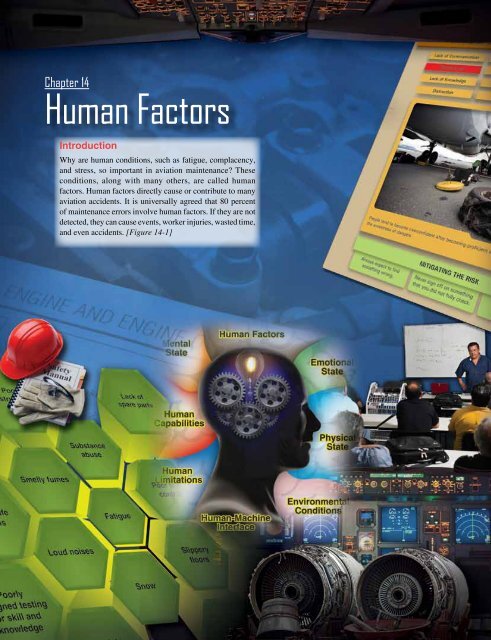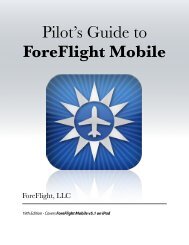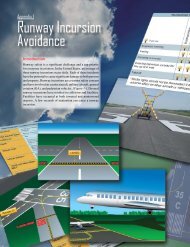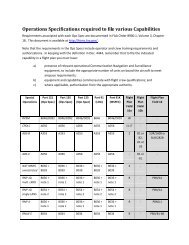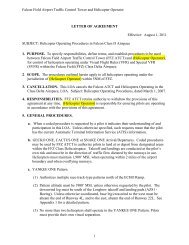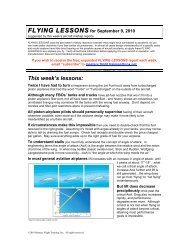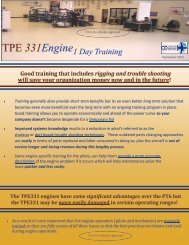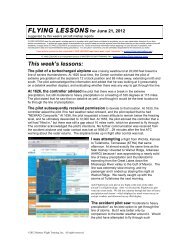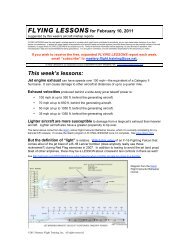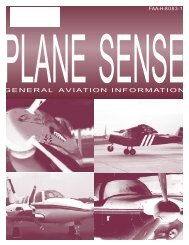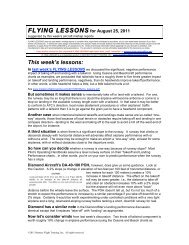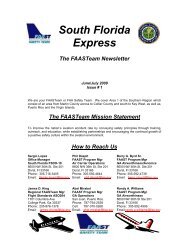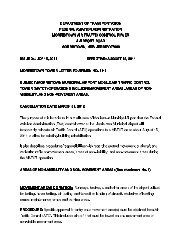Addendum/Human Factors - FAA
Addendum/Human Factors - FAA
Addendum/Human Factors - FAA
You also want an ePaper? Increase the reach of your titles
YUMPU automatically turns print PDFs into web optimized ePapers that Google loves.
MentalState<strong>Human</strong> <strong>Factors</strong>EmotionalStatemaintenance errors are parts installed incorrectly, missingparts, and necessary checks not being performed. Incomparison to many other threats to aviation safety, themistakes of an aviation maintenance technician (AMT) can bemore difficult to detect. Often times, these mistakes are presentbut not visible and have the potential to remain latent, affectingthe safe operation of aircraft for longer periods of time.<strong>Human</strong>Capabilities<strong>Human</strong>Limitations<strong>Human</strong>-MachineInterfacePhysicalStateEnvironmentalConditionsAMTs are confronted with a set of human factors uniquewithin aviation. Often times, they are working in the eveningor early morning hours, in confined spaces, on platforms thatare up high, and in a variety of adverse temperature/humidityconditions. The work can be physically strenuous, yet it alsorequires attention to detail. [Figure 14-2] Because of thenature of the maintenance tasks, AMTs commonly spend moretime preparing for a task than actually carrying it out. Properdocumentation of all maintenance work is a key element, andAMTs typically spend as much time updating maintenancelogs as they do performing the work. [Figure 14-3]Figure 14-1. <strong>Human</strong> factors and how they affect people are veryimportant to aviation maintenance.Aviation safety relies heavily on maintenance. When it isnot done correctly, it contributes to a significant proportionof aviation accidents and incidents. Some examples of<strong>Human</strong> factors awareness can lead to improved quality, anenvironment that ensures continuing worker and aircraftsafety, and a more involved and responsible work force. Morespecifically, the reduction of even minor errors can providemeasurable benefits including cost reductions, fewer missedFigure 14-2. Aviation maintenance technicians (AMTs) are confronted with many human factors due to their work environments.14-2
Elements of <strong>Human</strong> <strong>Factors</strong><strong>Human</strong> factors are comprised of many disciplines.This section discusses ten of those disciplines: ClinicalPsychology, Experimental Psychology, Anthropometrics,Computer Science, Cognitive Science, Safety Engineering,Medical Science, Organizational Psychology, EducationalPsychology, and Industrial Engineering. [Figure 14-5]Figure 14-3. AMT documenting repair work.deadlines, reduction in work related injuries, reduction ofwarranty claims, and reduction in more significant events thatcan be traced back to maintenance error. Within this chapter,the many aspects of human factors are discussed in relation toaviation maintenance. The most common human factors areintroduced along with ways to mitigate the risk to stop themfrom developing into a problem. Several Federal AviationAdministration (<strong>FAA</strong>) human factor resources are providedto include the most direct link to aviation maintenance humanfactors which can be found at https://hfskyway.faa.gov.What is <strong>Human</strong> <strong>Factors</strong>The term human factors has grown increasingly popular as thecommercial aviation industry realize that human error, ratherthan mechanical failure, underlies most aviation accidentsand incidents. <strong>Human</strong> factors science or technologies aremultidisciplinary fields incorporating contributions frompsychology, engineering, industrial design, statistics,operations research, and anthropometry. It is a term thatcovers the science of understanding the properties of humancapability, the application of this understanding to the design,development, and deployment of systems and services, andthe art of ensuring successful application of human factorprinciples into the maintenance working environment.The list of human factors that can affect aviation maintenanceand work performance is broad. They encompass a wide rangeof challenges that influence people very differently as humansdo not all have the same capabilities, strengths, weaknesses,or limitations. Unfortunately, aviation maintenance tasks thatdo not account for the vast amount of human limitations canresult in technical error and injuries. Figure 14-4 shows someof the human factors that affect AMTs. Some are more seriousthan others but, in most cases, when you combine three orfour of the factors, they create a problem that contributes toan accident or incident.The study and application of human factors is complexbecause there is not just one simple answer to fix orchange how people are affected by certain conditions orsituations. Aviation maintenance human factors researchhas the overall goal to identify and optimize the factors thataffect human performance in maintenance and inspection.The focus initiates on the technician but extends to theentire engineering and technical organization. Research isoptimized by incorporating the many disciplines that affecthuman factors and help to understand how people can workmore efficiently and maintain work performance.By understanding each of the disciplines and applying themto different situations or human behaviors, we can correctlyrecognize potential human factors and address them beforethey develop into a problem or create a chain of problemsthat result in an accident or incident.Clinical PsychologyClinical psychology includes the study and application ofpsychology for the purpose of understanding, preventing, andrelieving psychologically-based distress or dysfunction andto promote subjective well-being and personal development.It focuses on the mental well-being of the individual. Clinicalpsychology can help individuals deal with stress, copingmechanisms for adverse situations, poor self image, andaccepting criticism from coworkers.Experimental PsychologyExperimental psychology includes the study of a variety ofbasic behavioral processes, often in a laboratory environment.These processes may include learning, sensation, perception,human performance, motivation, memory, language,thinking, and communication, as well as the physiologicalprocesses underlying behaviors, such as eating, reading, andproblem solving. In an effort to test the efficiency of workpolicies and procedures, experimental studies help measureperformance, productivity, and deficiencies.AnthropometricsAnthropometry is the study of the dimensions and abilities ofthe human body. This is essential to aviation maintenance dueto the environment and spaces that AMTs have to work with.14-3
Industrial EngineeringClinical PsychologyExperimental PsychologyAnthropometric ScienceEducational Psychology<strong>Human</strong><strong>Factors</strong>0 10 20 30Not Complex Flight Exercise Caution Area of ConcernEndangermentLow RiskOrganization PsychologySafety EngineeringCognitive ScienceMedical ScienceComputer ScienceFigure 14-5. <strong>Human</strong> factor disciplines.learning and decision mechanisms to high-level logic andplanning. AMTs must possess a great ability to problem solvequickly and efficiently. They constantly have to troubleshoota situation and quickly react to it. This can be a viscous cyclecreating an enormous amount of stress. The discipline ofcognitive science helps us understand how to better assistAMTs during situations that create high levels of stress sothat their mental process does not get interrupted and effecttheir ability to work.Safety EngineeringSafety engineering assures that a life-critical system behavesas needed even when the component fails. Ideally, safetyengineers take an early design of a system, analyze it to findwhat faults can occur, and then propose safety requirementsin design specifications up front and changes to existingsystems to make the system safer. Safety cannot be stressedenough when it comes to aviation maintenance, and everyonedeserves to work in a safe environment. Safety engineeringplays a big role in the design of aviation maintenancefacilities, storage containers for toxic materials, equipmentused for heavy lifting, and floor designs to ensure no one slips,trips, or falls. In industrial work environments, the guidelinesof the Occupational Safety and Health Administration(OSHA) are important.Medical ScienceMedicine is the science and art of healing. It encompassesa variety of health care practices evolved to maintain andrestore health by the prevention and treatment of illness.Disposition and physical well-being are very important anddirectly correlated to human factors. Just like people comein many shapes and sizes, they also have very differentreactions to situations due to body physiology, physicalstructures, and biomechanics.Organizational PsychologyOrganizational psychologists are concerned with relationsbetween people and work. Their interests includeorganizational structure and organizational change, workers’productivity and job satisfaction, consumer behavior,and the selection, placement, training, and developmentof personnel. Understanding organizational psychologyhelps aviation maintenance supervisors learn about thepoints listed below that, if exercised, can enhance the workenvironment and productivity.• Rewards and compensations for workers with goodsafety records.• Motivated workers that want to do well and worksafely.14-5
• Unified work teams and groups that get along andwork together to get the job done right.• Treat all workers equally.Educational PsychologyEducational psychologists study how people learn anddesign the methods and materials used to educate people ofall ages. Everyone learns differently and at a different pace.Supervisors should design blocks of instruction that relateto a wide variety of learning styles.Industrial EngineeringIndustrial engineering is the organized approach to the studyof work. It is important for supervisors to set reasonable workstandards that can be met and exceeded. Unrealistic workstandards create unnecessary stressors that cause mistakes.It is also beneficial to have an efficient facility layout so thatthere is room to work. Clean and uncluttered environmentsenhance work performance. Another aspect of industrialengineering that helps in the understanding of human factorsis the statistical analysis of work performance. Concrete dataof work performance, whether good or bad, can show thecontributing factors that may have been present when thework was done.History of <strong>Human</strong> <strong>Factors</strong>Around 1487, Leonardo DiVinci began research in thearea of anthropometrics. The Vitruvian Man, one of hismost famous drawings, can be described as one of theearliest sources presenting guidelines for anthropometry.[Figure 14-6] Around the same time, he also began tostudy the flight of birds. He grasped that humans are tooheavy and not strong enough to fly using wings simplyattached to the arms. Therefore, he sketched a device inwhich the aviator lies down on a plank and works two large,membranous wings using hand levers, foot pedals, and asystem of pulleys. [Figure 14-7] Today, anthropometry playsa considerable role in the fields of computer design, designfor access and maintainability, simplicity of instructions, andergonomics issues.In the early 1900s, industrial engineers Frank and LillianGilbreth were trying to reduce human error in medicine.[Figures 14-8 and 14-9] They developed the concept ofusing call backs when communicating in the operating room.For example, the doctor says “scalpel” and the nurse repeats“scalpel” and then hands it to the doctor. That is called thechallenge-response system. Speaking out loud reinforces whattool is needed and provides the doctor with an opportunity tocorrect his/herself if that is not the necessary tool. This sameverbal protocol is used in aviation today. Pilots are requiredto read back instructions or clearances given by air trafficFigure 14-6. Vitruvian Man, one of Leonardo DiVinci’s famousdrawings about anthropometry.Figure 14-7. Leonardo DiVinci’s rendering of a flying devicefor man.control (ATC) to ensure that the pilot receives the correctinstructions and gives ATC an opportunity to correct if theinformation is wrong. Frank and Lillian Gilbreth also areknown for their research on fatigue.Also in the early 1900s, Orville and Wilbur Wright werethe first to fly a powered aircraft and also pioneered manyhuman factors considerations. While others were trying to14-6
Devil Hills, near Kitty Hawk, North Carolina, to developthe first practical human interactive controls for aircraftpitch, roll, and yaw. On December 17, 1903, they made fourcontrolled powered flights over the dunes at Kitty Hawk withtheir Wright Flyer. [Figure 14-10] They later developedpractical in-flight control of engine power, plus an angle ofattack sensor and stick pusher that reduced pilot workload.The brothers’ flight demonstrations in the United States andEurope during 1908-1909, awakened the world to the newage of controlled flight. Orville was the first aviator to use aseat belt and also introduced a rudder boost/trim control thatgave the pilot greater control authority. The Wrights’ flighttraining school in Dayton, Ohio included a flight simulatorof their own design. The Wrights patented their practicalairplane and flight control concepts, many of which are stillin use today.Figure 14-8. Frank Gilbreth – Industrial Engineer.Figure 14-10. The Wright Brothers on December 17, 1903, flyingover the dunes at Kitty Hawk with their Wright Flyer.Prior to World War I, the only test of human to machinecompatibility was that of trial and error. If the humanfunctioned with the machine, he was accepted, if not he wasrejected. There was a significant change in the concern forhumans during the American Civil War. The U.S. PatentOffice was concerned about whether the mass produceduniforms and new weapons could effectively be used by theinfantry men.Figure 14-9. Lillian Gilbreth – Industrial Engineer.develop aircraft with a high degree of aerodynamic stability,the Wrights intentionally designed unstable aircraft withcerebralized control modeled after the flight of birds. Between1901 and 1903, the brothers worked with large gliders at KillEvolution of Maintenance <strong>Human</strong> <strong>Factors</strong>With the onset of World War I (1914–1918), moresophisticated equipment was being developed and theinability of personnel to use such systems led to an increasedinterest in human capability. Up to this point, the focus ofaviation psychology was on the pilot, but as time progressed,the focus shifted onto the aircraft. Of particular concernwas the design of the controls and displays, the effects ofaltitude, and environmental factors on the pilot. The waralso brought on the need for aeromedical research and theneed for testing and measurement methods. By the end ofWorld War I, two aeronautical labs were established, one atBrooks Air Force Base, Texas, and the other at Wright Fieldoutside of Dayton, Ohio.14-7
Another significant development was in the civilian sector,where the effects of illumination on worker productivity wereexamined. This led to the identification of the HawthorneEffect, which suggested that motivational factors couldsignificantly influence human performance.With the onset of World War II (1939–1945), it wasbecoming increasingly harder to match individuals to preexistingjobs. Now the design of equipment had to take intoaccount human limitations and take advantage of humancapabilities. This change took time as there was a lot ofresearch to be done to determine the human capabilities andlimitations that had to be accomplished. An example of thisis the 1947 study done by Fitts and Jones, who studied themost effective configuration of control knobs to be used inaircraft flight decks. Much of this research transcended intoother equipment with the aim of making the controls anddisplays easier for the operators to use.In the initial 20 years after World War II, most human factorsresearch was done by Alphonse Chapanis, Paul Fitts, andArnold Small. The beginning of the Cold War led to a majorexpansion of Department of Defense supported researchlaboratories, and many of the labs established during the warstarted expanding. Most of the research following the war wasmilitary sponsored and large sums of money were granted touniversities to conduct research. The scope of the researchalso broadened from small equipment to entire workstationsand systems. In the civilian industry, the focus shifted fromresearch to participation through advice to engineers in thedesign of equipment.The Pear ModelThere are many concepts related to the science and practiceof human factors. However, from a practical standpoint, it ismost helpful to have a unified view of the things we shouldbe concerned about when considering aviation maintenancehuman factors. A good way to gain this understanding is byusing a model. For more than a decade, the term “PEAR” hasbeen used as a memory jogger, or mnemonic, to characterizehuman factors in aviation maintenance. PEAR promptsrecall of the four important considerations for human factorsprograms, which are listed below.• People who do the job.• Environment in which they work.• Actions they perform.• Resources necessary to complete the job.PeopleAviation maintenance human factors programs focus onthe people who perform the work and address physical,physiological, psychological, and psychosocial factors.[Figure 14-11] It must focus on individuals, their physicalcapabilities, and the factors that affect them. It also shouldconsider their mental state, cognitive capacity, and conditionsthat may affect their interaction with others. In most cases,human factors programs are designed around the peoplein the company’s existing workforce. You cannot applyidentical strength, size, endurance, experience, motivation,and certification standards equally to all employees. Thecompany must match the physical characteristics of eachperson to the tasks each performs.The company must consider factors like each person’s size,strength, age, eyesight, and more to ensure each person isphysically capable of performing all the tasks making up thejob. A good human factors program considers the limitationsof humans and designs the job accordingly. An importantPEOPLEPhysical• Physical size• Sex• Age• Strengh• Sensory limitationsPsychological• Nutritional <strong>Factors</strong>• Health• Lifestyle• Fatigue• Chemical dependencyPhysiological• Workload• Experience• Knowledge• Training• Attitude• Mental or emotional statePsychosocial• Interpersonal conflictsFigure 14-11. People who do the job.14-8
element when incorporating human factors into job design isplanned rest breaks. People can suffer physical and mentalfatigue under many work conditions. Adequate breaks and restperiods ensure the strain of the task does not overload theircapabilities. Another “People” consideration, which also isrelated to “E” for “Environment,” is ensuring there is properlighting for the task, especially for older workers. Annualvision testing and hearing exams are excellent proactiveinterventions to ensure optimal human physical performance.Attention to the individual does not stop at physical abilities.A good human factors program must address physiologicaland psychological factors that affect performance. Companiesshould do their best to foster good physical and mental health.Offering educational programs on health and fitness is oneway to encourage good health. Many companies have reducedsick leave and increased productivity by making healthymeals, snacks, and drinks available to their employees.Companies also should have programs to address issuesassociated with chemical dependence, including tobaccoand alcohol. Another “People” issue involves teamworkand communication. Safe and efficient companies find waysto foster communication and cooperation among workers,managers, and owners. For example, workers should berewarded for finding ways to improve the system, eliminatewaste, and help ensure continuing safety.EnvironmentThere are at least two environments in aviation maintenance.There is the physical workplace on the ramp, in the hangar,or in the shop. In addition, there is the organizationalenvironment that exists within the company. A humanfactors program must pay attention to both environments.[Figure 14-12]PhysicalThe physical environment is obvious. It includes ranges oftemperature, humidity, lighting, noise control, cleanliness,and workplace design. Companies must acknowledge theseconditions and cooperate with the workforce to eitheraccommodate or change the physical environment. It takes acorporate commitment to address the physical environment.This topic overlaps with the “Resources” component ofPEAR when it comes to providing portable heaters, coolers,lighting, clothing, and workplace and task design.OrganizationalThe second, less tangible, environment is the organizationalone. The important factors in an organizational environmentare typically related to cooperation, communication, sharedvalues, mutual respect, and the culture of the company.An excellent organizational environment is promoted withleadership, communication, and shared goals associatedwith safety, profitability, and other key factors. The bestcompanies guide and support their people and foster a cultureof safety. A safe culture is one where there is a shared valueand attitude toward safety. In a safe culture, each personunderstands their individual role is contributing to overallmission safety.ActionsSuccessful human factors programs carefully analyze all theactions people must perform to complete a job efficiently andsafely. Job task analysis (JTA) is the standard human factorsapproach to identify the knowledge, skills, and attitudesnecessary to perform each task in a given job. The JTA helpsidentify what instructions, tools, and other resources arenecessary. Adherence to the JTA helps ensure each workeris properly trained and each workplace has the necessaryequipment and other resources to perform the job. Manyregulatory authorities require the JTA serve as the basis forthe company’s general maintenance manual and trainingplan. Many human factors challenges associated with use ofjob cards and technical documentation fall under “Actions.”A crystal clear understanding and documentation of actionsensures instructions and checklists are correct and useable.[Figure 14-13]ENVIRONMENTPhysical• Weather• Location inside/outside• Workspace• Shift• Lighting• Sound level• SafetyOrganizational• Personnel• Supervision• Labor-management relations• Pressures• Crew structure• Size of company• Profitability• Morale• Corporate cultureFigure 14-12. Environment in which they work.14-9
ACTIONS• Steps to perform a task• Sequence of activity• Number of people involved• Information control requirements• Knowledge requirements• Skill requirements• Altitude requirements• Certification requirements• Inspection requirementsFigure 14-13. Actions they perform.ResourcesThe final PEAR letter is “R” for “Resources.”[Figure 14-14] Again, it is sometimes difficult to separateresources from the other elements of PEAR. In general, thecharacteristics of the people, environment, and actions dictatethe resources. Many resources are tangible, such as lifts,tools, test equipment, computers, technical manuals, and soforth. Other resources are less tangible. Examples includethe number and qualifications of staff to complete a job, theamount of time allocated, and the level of communicationamong the crew, supervisors, vendors, and others. Resourcesshould be viewed (and defined) from a broad perspective. Aresource is anything a technician (or anyone else) needs to getthe job done. For example, protective clothing is a resource.A mobile phone can be a resource. Rivets can be resources.What is important to the “Resource” element in PEAR isfocusing on identifying the need for additional resources.produces, it becomes extremely troublesome. Training, riskassessments, safety inspections, etc., should not be restrictedto attempt to avoid errors but rather to make them visible andidentify them before they produce damaging and regrettableconsequences. Simply put, human error is not avoidable butit is manageable. [Figure 14-15]HUMAN ERRORSAFETY<strong>Human</strong> Error<strong>Human</strong> error is defined as a human action with unintendedconsequences. There is nothing inherently wrong ortroublesome with error itself, but when you couple error withaviation maintenance and the negative consequences that itFigure 14-15. Safety awareness will help foresee and mitigate therisk of human error.RESOURCES• Procedures/work cards• Technical manuals• Other people• Test equipment• Tools• Computers/software• Paperwork/signoffs• Ground Handling equipment• Work stands and lifts• Fixtures• Materials• Task lighting• Training• Quality systemsFigure 14-14. Resources necessary to complete the job.14-10
Types of ErrorsUnintentionalAn unintentional error is an unintentional wandering ordeviation from accuracy. This can include an error inyour action (a slip), opinion, or judgment caused by poorreasoning, carelessness, or insufficient knowledge (amistake). For example, an AMT reads the torque values froma job card and unintentionally transposed the number 26 to 62.He or she did not mean to make that error but unknowinglyand unintentionally did. An example of an unintentionalmistake would be selecting the wrong work card to conducta specific repair or task. Again, not an intentional mistakebut a mistake nonetheless.IntentionalIn aviation maintenance, an intentional error should really beconsidered a violation. If someone knowingly or intentionallychooses to do something wrong, it is a violation, whichmeans that one has deviated from safe practices, procedures,standards, or regulations.Kinds of ErrorsActive and LatentAn active error is the specific individual activity that is anobvious event. A latent error is the company issues that leadup to the event. For example, an AMT climbs up a ladder todo a repair knowing that the ladder is broken. In this example,the active error was falling from the ladder. The latent errorwas the broken ladder that someone should have replaced.The “Dirty Dozen”Due to a large number of maintenance-related aviationaccidents and incidents that occurred in the late 1980s andearly 1990s, Transport Canada identified twelve humanfactors that degrade people’s ability to perform effectivelyand safely, which could lead to maintenance errors. Thesetwelve factors, known as the “dirty dozen,” were eventuallyadopted by the aviation industry as a straight forward meansto discuss human error in maintenance. It is important toknow the dirty dozen, how to recognize their symptoms,and most importantly, know how to avoid or contain errorsproduced by the dirty dozen. Understanding the interactionbetween organizational, work group, and individual factorsthat may lead to errors and accidents, AMTs can learn toprevent or manage them proactively in the future.Lack of CommunicationLack of communication is a key human factor that canresult in suboptimal, incorrect, or faulty maintenance.[Figure 14-16] Communication occurs between the AMTand many people (i.e., management, pilots, parts suppliers,aircraft servicers). Each exchange holds the potentialfor misunderstanding or omission. But communicationbetween AMTs may be the most important of all. Lackof communication between technicians could lead to amaintenance error and result in an aircraft accident. Thisis especially true during procedures where more than onetechnician performs the work on the aircraft. It is criticalthat accurate, complete information be exchanged to ensurethat all work is completed without any step being omitted.Knowledge and speculation about a task must be clarified andnot confused. Each step of the maintenance procedure mustbe performed according to approved instructions as thoughonly a single technician did the work.A common scenario where communication is critical and alack thereof can cause problems, is during shift change in anairline or fixed base operator (FBO) operation. A partiallycompleted job is transferred from the technician finishinghis or her workday to the technician coming on duty. Manysteps in a maintenance procedure are not able to be seen orverified once completed due to the installation of componentshiding the work. No steps in the procedure can be omittedand some steps still to be performed may be contingent onthe work already completed. The departing technician mustthoroughly explain what has occurred so that the arrivingtechnician can correctly complete the job. A recounting ofcritical steps and any difficulties encountered gives insight.A lack of communication at this juncture could result in thework being continued without certain required operationshaving been performed.The approved steps of a maintenance procedure must besigned off by the technician doing the work as it is performed.Continuing a job that has been started by someone else shouldonly occur after a face-to-face meeting of technicians. Theapplicable paperwork should be reviewed, the completedwork discussed, and attention for the next step should bedrawn. Absence of either a written or oral turnover servesas warning that an error could occur.It is vital that work not be continued on a project withoutboth oral and written communication between the technicianwho started the job and the technician continuing it. Workshould always be done in accordance with the approvedwritten procedure and all of the performed steps shouldbear the signature of the technician who accomplishes thework. If necessary, a phone call can be made to obtain anoral turnover when technicians cannot meet face-to-faceat the work area. In general, the technician must see his orher role as part of a greater system focused on safe aircraftoperation and must communicate well with all in that systemto be effective.14-11
THE DIRTY DOZENTwelve human factors for aircraft maintenance proficiencyLack of CommunicationComplacencyLack of KnowledgeDistractionLack of TeamworkFatigueLack of ResourcesPressureLack of AssertivenessStressLack of AwarenessNormsMaintainers must communicate with one another and explain what work has and has not beencompleted when changing shifts.MITIGATING THE RISKProperly use logbooks andworksheets to communicatework accomplishments.Ensure that maintenancepersonnel are discussingexactly what has been andneeds to be completedto the next shift.Never assume that the workhas been completed.Figure 14-16. Lack of communication.ComplacencyComplacency is a human factor in aviation maintenance thattypically develops over time. [Figure 14-17] As a techniciangains knowledge and experience, a sense of self satisfactionand false confidence may occur. A repetitive task, especiallyan inspection item, may be overlooked or skipped because thetechnician has performed the task a number of times withoutever finding a fault. The false assumption that inspectionof the item is not important may be made. However, evenif rare, a fault may exist. The consequences of the fault notbeing detected and corrected could cause an incident oraccident. Routine tasks performed over and over allow timefor the technician’s mind to wander, which may also resultin a required task not being performed.When a technician finds him or herself performing workwithout documentation, or documenting work that wasnot performed, it is a sign that complacency may exist.14-12
THE DIRTY DOZENTwelve human factors for aircraft maintenance proficiencyLack of CommunicationComplacencyLack of KnowledgeDistractionLack of TeamworkFatigueLack of ResourcesPressureLack of AssertivenessStressLack of AwarenessNormsPeople tend to become overconfident after becoming proficient in a certain task, which can maskthe awareness of dangers.MITIGATING THE RISKAlways expect to findsomething wrong.Never sign off on somethingthat you did not fully check.Always double checkyour work.Figure 14-17. Complacency.Approved, written maintenance procedures should befollowed during all maintenance inspections and repairs.Executing the proper paperwork draws attention to a workitem and reinforces its significance.To combat complacency, a technician must train oneself toexpect to find the fault that created the inspection item in thefirst place. He or she must stay mentally engaged in the taskbeing performed. All inspection items must be treated withequal importance, and it must never be assumed that an itemis acceptable when it has not been inspected. A technicianshould never sign for any work that has not been performed.Prior to the pen touching the paper for a signature, thetechnician should read the item before signing and confirmit has been performed.Lack of KnowledgeA lack of knowledge when performing aircraft maintenancecan result in a faulty repair that can have catastrophic results.[Figure 14-18] Differences in technology from aircraft toaircraft and updates to technology and procedures on a singleaircraft also make it challenging to have the knowledgerequired to perform airworthy maintenance.14-13
THE DIRTY DOZENTwelve human factors for aircraft maintenance proficiencyLack of CommunicationComplacencyLack of KnowledgeDistractionLack of TeamworkFatigueLack of ResourcesPressureLack of AssertivenessStressLack of AwarenessNormsIn a world of ever changing technology, maintainers must remain up to date on current equipmentand how to fix it.MITIGATING THE RISKOnly fix parts that you aretrained to fix.Ensure that the maintenancemanual you are using is upto date.If you do not know how tofix something, ask for helpfrom someone who does.Figure 14-18. Lack of knowledge.All maintenance must be performed to standards specifiedin approved instructions. These instructions are based onknowledge gained from the engineering and operation ofthe aircraft equipment. Technicians must be sure to use thelatest applicable data and follow each step of the procedureas outlined. They must also be aware that differences exist inthe design and maintenance procedures on different aircraft.It is important for technicians to obtain training on differenttypes of aircraft. When in doubt, a technician with experienceon the aircraft should be consulted. If one is not available, orthe consulted technician is not familiar with the procedure, amanufacturer’s technical representative should be contacted.It is better to delay a maintenance procedure than to do itincorrectly and cause an accident.DistractionA distraction while performing maintenance on an aircraftmay disrupt the procedure. [Figure 14-19] When workresumes, it is possible that the technician skips over adetail that needs attention. It is estimated that 15 percent ofmaintenance related errors are caused by distractions.14-14
THE DIRTY DOZENTwelve human factors for aircraft maintenance proficiencyLack of CommunicationComplacencyLack of KnowledgeDistractionLack of TeamworkFatigueLack of ResourcesPressureLack of AssertivenessStressLack of AwarenessNormsA distraction could be anything that takes your mind off the task that is being done. Any distractionwhile working can cause us to think we are further ahead in the process than we actually are.MITIGATING THE RISKOnce returning to the job, goback through all of the stepsto ensure where you left off.Use a detailed checklist.Never leave tools or partslying around. Secure thembefore leaving the area.Figure 14-19. Distraction.Distractions can be mental or physical in nature. They canoccur when the work is located on the aircraft or in thehangar. They can also occur in the psyche of the technicianindependent of the work environment. Something as simpleas a cell phone call or a new aircraft being pushed into thehangar can disrupt the technician’s concentration on a job.Less visible is a difficult family or financial matter or otherpersonal issues that may occupy the technicians thoughtprocess as work is performed. This can make performanceof the required maintenance less effective.Regardless of their nature, numerous distractions may occurduring the course of maintaining an aircraft. The technicianmust recognize when attention to the job at hand is beingdiverted and assure that work continues correctly. A goodpractice is to go back three steps in the work procedure whenone is distracted and resume the job from that point. Use of adetailed step-by-step written procedure and signing off eachstep only after it is completed also helps. Incomplete workcan be marked or tagged, especially when the technician ispulled from the work by a distraction, and it is unknown14-15
when work will be resumed and by whom. Disconnect anyconnector and leave it plainly visible if an installation is notcomplete. There is a tendency to think a job is finished whena component is “hooked up.” Similarly, when a step in themaintenance procedure is complete, be sure to immediatelylock wire or torque the fasteners if required. This can be usedas an indication that all is well up to that point in the procedure.Lack of TeamworkA lack of teamwork may also contribute to errors in aircraftmaintenance. [Figure 14-20] Closely related to lack ofcommunication, teamwork is required in aviation maintenancein many instances. Sharing of knowledge between technicians,coordinating maintenance functions, turning work over fromshift to shift, and working with flight personnel to troubleshootand test aircraft are all are executed better in an atmosphereof teamwork. Often associated with improved safety in theworkplace, teamwork involves everyone understandingand agreeing on actions to be taken. A gear swing or otheroperational check involves all the members of a team workingtogether. Multiple technicians contribute to the effort to ensurea single outcome. They communicate and look out for oneTHE DIRTY DOZENTwelve human factors for aircraft maintenance proficiencyLack of CommunicationComplacencyLack of KnowledgeDistractionLack of TeamworkFatigueLack of ResourcesPressureLack of AssertivenessStressLack of AwarenessNormsPersonality difference in the workplace must be left at the door. Organizations should emphasizethat a lack of teamwork can ultimately effect the safety of maintenance work.MITIGATING THE RISKEnsure that lines ofcommunication are openbetween personnel.Discuss specific duties whenjobs require more than oneperson to eliminate anyquestions.Always look out forco-workers with safetyin mind.Figure 14-20. Lack of teamwork.14-16
another as they do the job. A consensus is formed that theitem is airworthy or not airworthy.The technician primarily deals with the physical aspect ofthe aircraft and its airworthiness. Others in the organizationperform their roles and the entire company functions as ateam. Teams can win or lose depending on how well everyonein the organization works together toward a commonobjective. A lack of teamwork makes all jobs more difficultand, in maintenance, could result in a miscommunicationthat affects the airworthiness of the aircraft.FatigueFatigue is a major human factor that has contributedto many maintenance errors resulting in accidents.[Figure 14-21] Fatigue can be mental or physical in nature.Emotional fatigue also exists and effects mental and physicalperformance. A person is said to be fatigued when a reductionor impairment in any of the following occurs: cognitiveability, decision-making, reaction time, coordination, speed,strength, and balance. Fatigue reduces alertness and oftenreduces a person’s ability to focus and hold attention on thetask being performed.THE DIRTY DOZENTwelve human factors for aircraft maintenance proficiencyLack of CommunicationComplacencyLack of KnowledgeDistractionLack of TeamworkFatigueLack of ResourcesPressureLack of AssertivenessStressLack of AwarenessNormsOccupations that require an individual to work long hours or stay up overnight can lead to fatigue.Fatigue can cause a decrease of attention and a decreased level of consciousness, which can bevery dangerous when conducting maintenance.MITIGATING THE RISKBe aware of the symptomsand look for them in yourselfand coworkers.Forfeit complex tasks if youknow you are exhausted.Eating healthy, exercisingand regular sleep patternscan prevent fatigue.Figure 14-21. Fatigue.14-17
Symptoms of fatigue may also include short-term memoryproblems, channeled concentration on unimportant issueswhile neglecting other factors that may be more important,and failure to maintain a situational overview. A fatiguedperson may be easily distracted or may be nearly impossibleto distract. He or she may experience abnormal mood swings.Fatigue results in an increase in mistakes, poor judgment,and poor decisions or perhaps no decisions at all. A fatiguedperson may also lower his or her standards.Tiredness is a symptom of fatigue. However, sometimes afatigued person may feel wide awake and engaged in a task.The primary cause of fatigue is a lack of sleep. Good restfulsleep, free from drugs or alcohol is a human necessity toprevent fatigue. Fatigue can also be caused by stress andoverworking. A person’s mental and physical state alsonaturally cycles through various levels of performance eachday. Variables such as body temperature, blood pressure,heart rate, blood chemistry, alertness, and attention riseand fall in a pattern daily. This is known as one’s circadianrhythm. [Figure 14-22] A person’s ability to work (and rest)rises and falls during this cycle. Performance counter tocircadian rhythm can be difficult. Until it becomes extreme,a person may be unaware that he or she is fatigued. It iseasier recognized by another person or in the results of tasksbeing performed. This is particularly dangerous in aviationmaintenance since the lives of people depend on maintenanceprocedures performed at a high level of proficiency. Workingalone when fatigued is particularly dangerous.The best remedy for fatigue is to get enough sleep on a regularbasis. The technician must be aware of the amount and qualityof sleep obtained. Caution or time off is justified when too littlesleep has occurred and errors are probable during maintenance.Countermeasures to fatigue are often used. Effectivenesscan be short lived and many countermeasures may makefatigue worse. Caffeine is a common fatigue countermeasure.Pseudoephedrine found in sinus medicine and amphetaminesare also used. While effective for short periods, a fatiguedperson remains fatigued and may have trouble getting the restneeded once off the job due to this drug use.Suggestions to help mitigate the problems caused by fatigueinclude looking for symptoms of fatigue in one’s self and inothers. Have others check your work, even if an inspector signoff is not required. Avoid complex tasks during the bottomof your circadian rhythm. Sleep and exercise daily. Eight tonine hours of daily sleep are recommended to avoid fatigue.AMTs in airline operations are part of a system in which mostmaintenance is performed at night. Fleet aircraft are operatedprimarily during the daytime hours to generate companyrevenue. Therefore, shift work is required to maintain thefleet. It is already known that turning work over to othertechnicians during shift change is a problem that can lead toerrors due to lack of communication. But shift work alone isa cause of fatigue that can degrade performance and also leadto errors. Shift work requires technicians to work during lowcycles of their natural circadian rhythm. It also makes sleepmore difficult when not on the job. Furthermore, regular nightshift work makes one’s body more sensitive to environmentaldisturbances. It can degrade performance, morale, andsafety. It can also affect one’s physical health. All of thesecan be reflected in degraded maintenance performance—adangerous situation.The technician must be aware that shift work is the norm inaviation. Avoidance of fatigue is part of the job. Title 14 ofthe Code of Federal Regulations (14 CFR) part 121, sectionAlertness Level Multiple Sleep Latency Test (MSLT)201510501-3 AM9 12 15 18 21 24 3 6 9Time of DayPeak alertnessSlightlyimpairedReducedalertnessDangerouslydrowsyFigure 14-22. Many human variables rise and fall daily due to one’s natural circadian rhythm.14-18
377, only requires 24 hours time off during a week of work.Since this is obviously not enough, it is up to companies andtechnicians to regulate shift work and time off to reduce thepotential for errors. Most importantly, each technician mustmonitor and control his or her sleep habits to avoid fatigue.Lack of ResourcesA lack of resources can interfere with one’s ability tocomplete a task because there is a lack of supply and support.[Figure 14-23] Low quality products also affect one’s abilityto complete a task. Aviation maintenance demands propertools and parts to maintain a fleet of aircraft. Any lack ofresources to safely carry out a maintenance task can causeboth non-fatal and fatal accidents. For example, if an aircraftis dispatched without a functioning system that is typicallynot needed for flight but suddenly becomes needed, this couldcreate a problem.Parts are not the only resources needed to do a job properly,but all too frequently parts become a critical issue. AMTs canTHE DIRTY DOZENTwelve human factors for aircraft maintenance proficiencyLack of CommunicationComplacencyLack of KnowledgeDistractionLack of TeamworkFatigueLack of ResourcesPressureLack of AssertivenessStressLack of AwarenessNormsWhen there is a lack of resources available to properly fix something, a decision should be madeto cease maintenance until the proper parts are available.MITIGATING THE RISKMaintain a sufficient supplyof parts and order anyanticipated parts before theyare required.Never replace a part with onethat is not compatible for thesake of getting the job done.Preserve all equipmentthrough proper maintenance.Figure 14-23. Lack of resources.14-19
try to be proactive by checking suspected areas or tasks thatmay require parts at the beginning of the inspection. Aircrafton ground (AOG) is a term in aviation maintenance indicatingthat a problem is serious enough to prevent an aircraft fromflying. Generally, there is a rush to acquire the parts to putthe aircraft back into service and prevent further delays orcancellations of the planned itinerary. AOG applies to anyaviation materials or spare parts that are needed immediatelyfor an aircraft to return to service. AOG suppliers referqualified personnel and dispatch the parts required to repairthe aircraft for an immediate return to service. AOG also isused to describe critical shipments for parts or materials foraircraft “out of service” (OTS) at a location.If the status of an aircraft is AOG and materials required arenot on hand, parts and personnel must be driven, flown, orsailed to the location of the grounded aircraft. Usually theproblem is escalated through an internal AOG desk, thenthe manufacturer’s AOG desk, and finally competitors’AOG desks. All major air carriers have an AOG desk that ismanned 24 hours a day, 7 days a week by personnel trainedin purchasing, hazardous materials shipping, and partsmanufacturing and acquisition processes.Within an organization, making sure that personnel have thecorrect tools for the job is just as important as having theproper parts when they are needed. Having the correct toolsmeans not having to improvise. For example, an aircraft thathad received a new interior needed to be weighed prior tobeing released to fly. Two days before the planned release, theaircraft was weighed without the proper electronic load cellsplaced between the aircraft jack and the aircraft. Because thecorrect equipment was not used, the aircraft slipped off of oneof the load cells and the jack point creased the spar. The costof improvising can be very steep. The right tools to do thejob need to be used at all times, and if they are broken, out ofcalibration, or missing, they need to be repaired, calibrated,or returned as soon as possible.Technical documentation is another critical resource that canlead to problems in aviation maintenance. When trying tofind out more about the task at hand or how to troubleshootand repair a system, often the information needed cannot befound because the manuals or diagrams are not available.If the information is not available, personnel should aska supervisor or speak with a technical representativeor technical publications department at the appropriateaircraft manufacturer. Most manuals are in a constant stateof revision and, if organizations do not identify missinginformation in the manuals, then nothing is done to correct thedocumentation. Resources, such as publication departmentsand manufacturer’s technical support, are available andshould be used rather than ignoring the problem.Another valuable resource that the maintenance departmentshould rely on is the flight crew. Organizations shouldencourage open communication between the flight crewsand the maintenance crews. The flight crew can providevaluable information when dealing with a defective part orproblem. Figure 14-24 shows a number of questions thatflight crews can be asked to help resolve and understandmaintenance issues.When and where the event occurred?Were there any indications prior to failure?Did the system surge or flicker?How often does the system cycle?What was the range of transmission or reception?What was the time of retractions or extensions?Were there noises in the aircraft or headsets?Were there vibrations, stiffness of system controls?Was irregular trim required?Was there ease or lack of control?Where smoke or fumes present?Was there a loss of amperage and/or voltage?Figure 14-24. Questions that technicians can ask flight crews in aneffort to resolve and understand maintenance issues of resources.When the proper resources are available for the task at hand,there is a much higher probability that maintenance will doa better, more efficient job and higher likelihood that thejob will be done correctly the first time. Organizations mustlearn to use all of the resources that are available and, ifthe correct resources are not available, make the necessaryarrangements to get them in a timely manner. The end resultsaves time, money, and enables organizations to completethe task knowing the aircraft is airworthy.PressureAviation maintenance tasks require individuals to performin an environment with constant pressure to do things betterand faster without making mistakes and letting thingsfall through the cracks. Unfortunately, these types of jobpressures can affect the capabilities of maintenance workers14-20
THE DIRTY DOZENTwelve human factors for aircraft maintenance proficiencyLack of CommunicationComplacencyLack of KnowledgeDistractionLack of TeamworkFatigueLack of ResourcesPressureLack of AssertivenessStressLack of AwarenessNormsPressure to get things repaired is always present in aviation. Maintainers must not let thepressures of time constraints get in the way with safely finishing a repair.MITIGATING THE RISKEnsure that the pressure isnot self induced.Communicate if you thinkyou will need more time tocomplete a repair rather thanrush through it.Ask for extra help if time isan issue.Figure 14-25. Pressure.to get the job done right. [Figure 14-25] Airlines have strictfinancial guidelines, as well as tight flight schedules, thatforce mechanics to be under pressure to identify and repairmechanical problems quickly so that the airline industrycan keep moving. Most important, aircraft mechanics areresponsible for the overall safety of everyone who uses flyingas a mode of transportation.Organizations must be aware of the time pressures that are puton aircraft mechanics and help them manage all of the tasksthat need to be completed so that all repairs, while done in atimely manner, are completed correctly with safety being theultimate goal. Sacrificing quality and safety for the sake of timeshould not be tolerated or accepted. Likewise, AMTs need torecognize on their own when time pressures are clouding theirjudgments and causing them to make unnecessary mistakes.Self-induced pressures are those occasions where one takesownership of a situation that was not of their doing.In an effort to combat self-induced pressure, techniciansshould ask for help if they feel overwhelmed and under atime constraint to get a repair fixed. Another method is to14-21
have someone check the repair thoroughly to ensure that allmaintenance tasks were completed correctly.Lastly, if given a repair with a specific time limitation thatyou do not feel is realistic or compromises safety, bring it tothe attention of the organization’s management and openlydiscuss a different course of action.Lack of AssertivenessAssertiveness is the ability to express your feelings, opinions,beliefs, and needs in a positive, productive manner and shouldnot be confused with being aggressive. [Figure 14-26] Itis important for AMTs to be assertive when it pertains toaviation repair rather than choosing or not being allowed tovoice their concerns and opinions. The direct result of notbeing assertive could ultimately cost people their lives. Thefollowing are examples of how a lack of assertiveness canbe offset:1. Address managers and supervisors directly by statingthe problem.Example: “John, I have a concern with how this repairis being rushed.”2. Explain what the consequences will be.Example: “If we continue, the result will be that thepart will break sooner rather than later.”3. Propose possible solutions to the problem.Example: “We could try doing things another way oryou may want to try this way.”4. Always solicit feedback and include other opinions.Example: “John, what do you think?”THE DIRTY DOZENTwelve human factors for aircraft maintenance proficiencyLack of CommunicationComplacencyLack of KnowledgeDistractionLack of TeamworkFatigueLack of ResourcesPressureLack of AssertivenessStressLack of AwarenessNormsLack of assertiveness in failing to alert others when something does not seem right, can result in manyfatal accidents. Do not let something that you know is wrong continue by ignoring that it is there.MITIGATING THE RISKProvide clear feedback whena risk or danger is perceived.Never compromise yourstandards.Allow co-workers to givetheir opinions and alwaysaccept corrective criticisms.Figure 14-26. Lack of assertiveness.14-22
When being assertive with co-workers or management,deal with one issue at a time rather than trying to tackle anumber of problems at once. It is also important to havedocumentation and facts to back up your argument, which cangive people a visual account of what you are trying to explain.A lack of assertiveness in failing to speak up when thingsdo not seem right has resulted in many fatal accidents. Thiscan easily be changed by promoting good communicationbetween co-workers and having an open relationship withsupervisors and management. Maintenance managers must befamiliar with the behavior style of the people they superviseand learn to utilize their talents, experience, and wisdom.As the employees become aware of behavior styles andunderstand their own behavior, they see how they unwittinglycontribute to some of their own problems and how they canmake adjustments. Assertive behavior may not be a skill thatcomes naturally to every individual, but it is a critical skillto achieve effectiveness. AMTs should give supervisors andmanagement the kind of feedback required to ensure that theywill be able to assist the mechanic to do their job.StressAviation maintenance is a stressful task due to many factors.[Figure 14-27] Aircraft must be functional and flying in orderfor airlines to make money, which means that maintenancemust be done within a short timeframe to avoid flight delaysand cancellations. Fast-paced technology that is alwayschanging can add stress to technicians. This demands thatAMTs stay trained on the latest equipment. Other stressorsinclude working in dark, tight spaces, lack of resources toget the repair done correctly, and long hours. The ultimatestress of aviation maintenance is knowing that the work theydo, if not done correctly, could result in tragedy.Everyone handles stress differently and particular situationscan bring about different degrees of difficulty for differentpeople. For example, working under a strict timelinecan be a stressor for one person and normal for another.The causes of stress are referred to as stressors. They arecategorized as physical, psychological, and physiologicalstressors. Following, is a list of each and how they mayaffect maintenance.Physical StressorsPhysical stressors add to the personnel’s workload and makeit uncomfortable for him or her in their work environment.• Temperature—high temperatures in the hangerincreases perspiration and heart rate causing the bodyto overheat. Low temperatures can cause the body tofeel cold, weak, and drowsy.• Noise—hangers that have high noise levels (due toaircraft taking off and landing close by) can makeit difficult for maintenance personnel to focusand concentrate.• Lighting—poor lighting within a work space makesit difficult to read technical data and manuals.Likewise, working inside an aircraft with poor lightingincreases the propensity to miss something or to repairsomething incorrectly.• Confined spaces—small work spaces make it verydifficult to perform tasks as technicians are oftencontorted into unusual positions for a long periodof time.Psychological StressorsPsychological stressors relate to emotional factors, suchas a death or illness in the family, business worries, poorinterpersonal relationships with family, co-workers,supervisors, and financial worries.• Work-related stressors—over anxiousness can hinderperformance and speed while conducting maintenanceif there is any apprehension about how to do a repairor concerns about getting it done on time.• Financial problems—impending bankruptcy,recession, loans, and mortgages are a few examplesof financial problems that can create stressors.• Marital problems—divorce and strained relationshipscan interfere with one’s ability to perform theirjob correctly.• Interpersonal problems—problems with superiorsand colleagues due to miscommunication orperceived competition and backstabbing can causea hostile work environment.Physiological StressorsPhysiological stressors include fatigue, poor physicalcondition, hunger, and disease.• Poor physical condition—trying to work when illor not feeling well can force the body to use moreenergy fighting the illness and less energy to performvital tasks.• Proper meals—not eating enough, or foods lacking theproper nutrition, can result in low energy and inducesymptoms like headaches and shaking.• Lack of sleep—fatigued, the maintainer is unableto perform to standard for long periods of timeand can become sloppy with repairs and missimportant mistakes.• Conflicting shift schedules—the affect of changingsleep patterns on the body’s circadian cycle can leadto a degradation of performance.14-23
THE DIRTY DOZENTwelve human factors for aircraft maintenance proficiencyLack of CommunicationComplacencyLack of KnowledgeDistractionLack of TeamworkFatigueLack of ResourcesPressureLack of AssertivenessStressLack of AwarenessNormsStress is the subconscious response to the demands placed on a person.MITIGATING THE RISKTake time off or a shortbreak if you are feelingstressed.Discuss with a co-worker andask them to monitor yourwork.Healthy eating, exercise, anda sufficient amount of restcan reduce stress levels.Figure 14-27. Stress.People cope with stress in many different ways. Specialistssay that the first step is to identify stressors and thesymptoms that occur after exposure to those stressors. Otherrecommendations involve development or maintenance of ahealthy lifestyle with adequate rest and exercise, a healthydiet, limited consumption of alcoholic drinks, and avoidanceof tobacco products.Lack of AwarenessLack of awareness is defined as a failure to recognize all theconsequences of an action or lack of foresight. [Figure 14-28]In aviation maintenance, it is not unusual to perform the samemaintenance tasks repeatedly. After completing the sametask multiple times, it is easy for technicians to become lessvigilant and develop a lack of awareness for what they aredoing and what is around them. Each time a task is completedit must be treated as if it were the first time.NormsNorms is short for “normal,” or the way things are normallydone. [Figure 14-29] They are unwritten rules that arefollowed or tolerated by most organizations. Negative normscan detract from the established safety standard and causean accident to occur. Norms are usually developed to solveproblems that have ambiguous solutions. When faced withan ambiguous situation, an individual may use another’s14-24
THE DIRTY DOZENTwelve human factors for aircraft maintenance proficiencyLack of CommunicationComplacencyLack of KnowledgeDistractionLack of TeamworkFatigueLack of ResourcesPressureLack of AssertivenessStressLack of AwarenessNormsAfter completing the same tasks multiple times, maintainers can develop a lack of awareness forwhat is around them. Common sense and vigilance tend to not be present because they havecompleted the same task so many times.MITIGATING THE RISKCheck to see if what you areworking on conflicts with anexisting modification orrepair.Always ask co-workers tocheck your work.Even if you are highlyproficient in a task, alwayshave someone checkyour work.Figure 14-28. Lack of awareness.behavior as a frame of reference around which to formhis or her own reactions. As this process continues, groupnorms develop and stabilize. Newcomers to the situation arethen accepted into the group based on adherence to norms.Very rarely do newcomers initiate change in a group withestablished norms.Some norms are unsafe in that they are non-productive ordetract from the productivity of the group. Taking shortcuts inaircraft maintenance, working from memory, or not followingprocedures are examples of unsafe norms. Newcomers arebetter able to identify these unsafe norms than long-standingmembers of the group. On the other hand, the newcomer’scredibility depends on his or her assimilation into the group.The newcomer’s assimilation, however, depends on adherenceto the group norms. Everyone should be aware of theperceptiveness of newcomers in identifying unhealthy normsand develop a positive attitude toward the possibility thatnorms may need to be changed. Finally, as newcomers becomeassimilated into the group structure, they build credibility withothers. Once this has been done, a relative newcomer maybegin to institute change within the group. Unfortunately,14-25
THE DIRTY DOZENTwelve human factors for aircraft maintenance proficiencyLack of CommunicationComplacencyLack of KnowledgeDistractionLack of TeamworkFatigueLack of ResourcesPressureLack of AssertivenessStressLack of AwarenessNormsNorms is short for “normal,” or the way things are normally done. They are unwritten rules thatare followed or tolerated by most of the organization. Negative norms can detract from theestablished safety standard and cause an accident to occur.MITIGATING THE RISKEnsure that everyone followsthe same standard.Be aware that just because itseems normal does not makeit correct.The easiest way ofaccomplishing somethingmay not be the standard.Figure 14-29. Norms.such actions are often difficult to do and rely heavily on thegroup’s perception of the newcomer’s credibility.Norms have been identified as one of the dirty dozen inaviation maintenance and a great deal of anecdotal evidencepoints to the use of unsafe norms on the line. The effect ofunsafe norms may range from the relatively benign, such asdetermining accepted meeting times, to the inherently unsafe,such as signing off on incomplete maintenance tasks. Anybehavior commonly accepted by the group, whether as astandard operating procedure (SOP) or not, can be a norm.Supervisors need to ensure that everyone adheres to the samestandards and not tolerate unsafe norms. AMTs should pridethemselves on following procedure, rather than unsafe normsthat may have been adopted as regular practice.Example of Common Maintenance ErrorsIn an effort to identify the most frequently occurringmaintenance discrepancies, the United Kingdom CivilAviation Authority (CAA) conducted in-depth studies ofmaintenance sites on aviation maintenance operations. Thefollowing list is what they found to be the most commonoccurring maintenance errors.14-26
1. Incorrect installation of components.2. Fitting of wrong parts.3. Electrical wiring discrepancies to include crossingconnections. [Figure 14-30]6. Failure to secure access panels, fairings, or cowlings.7. Fuel or oil caps and fuel panels not secured.8. Failure to remove lock pins. [Figure 14-32]IncidentOn March 20, 2001 a Lufthansa Airbus A320 almostcrashed shortly after takeoff because of reversed wiring inthe captain's sidestick flight control. Quick action by theco-pilot, whose sidestick was not faulty, prevented a crash.CauseThe investigation has focused on maintenance on thecaptain's controls carried out by Lufthansa Technik justbefore the flight. During the previous flight, a problem withone of the two elevator/aileron computers (ELAC) hadoccurred. An electrical pin in the connector was found tobe damaged and was replaced. It has been confirmed thattwo pairs of pins inside the connector had accidentallybeen crossed during the repair. This changed the polarityin the sidestick and the respective control channels“bypassing” the control unit, which might have sensed theerror and would have triggered a warning. Clues mighthave been seen on the electronic centralized aircraftmonitor (ECAM) screen during the flight control checks,but often pilots only check for a deflection indication, notthe direction. Before the aircraft left the hangar, a flightcontrol check was performed by the mechanic, but onlyusing the first officer’s sidestick.Lock pinFigure 14-32. Lock pins located on the wheels of an aircraft.Figure 14-30. A description of a Lufthansa Airbus A320 that almostcrashed due to reversed wiring of the flight controls.4. Forgotten tools and parts.5. Failure to lubricate. [Figure 14-31]AccidentAlaska Airlines Flight 261, a McDonnell Douglas MD-83aircraft, experienced a fatal accident on January 31, 2000,in the Pacific Ocean. The two pilots, three cabincrewmembers, and 83 passengers on board were killed andthe aircraft was destroyed.CauseThe subsequent investigation by the NationalTransportation Safety Board (NTSB) determined thatinadequate maintenance led to excessive wear andcatastrophic failure of a critical flight control system duringflight. The probable cause was stated to be “a loss ofairplane pitch control resulting from the in-flight failure ofthe horizontal stabilizer trim system jackscrew assembly’sacme nut threads. The thread failure was caused byexcessive wear resulting from Alaska Airlines insufficientlubrication of the jackscrew assembly.”Figure 14-31. A description of Alaska Airlines Flight 261 thatcrashed due to insufficient lubrication of the jackscrew assembly.All of the maintenance discrepancies listed above can beavoided if the proper procedures are followed on the jobcard that is being used. [Figure 14-33] Regardless of howmany times the task has been completed, each time you pickup a job card, treat it like it is the first time you have evercompleted the task with diligence and complete accuracy.UZ0030F1FZEMAINTENANCE JOB CARD1 OF 1 974711 OF 2 -4001 0.00 0.001 ZONE 221-222WORKNO A26JOB4ASSFOR - PORTABLE INTERFACE UNITD-4AD-NOTESOLID STATE FLIGHT DATA RECORDER (IF APPLICABLE)MS 31-31-00-007-002-500SSFDR DATA COPY(AMM 31-31-01)NOTE: THIS IS A DUPLICATE INSPECTION!PERFORMANCE AND INSPECTION MUST BE DONE BY TWO PERSONS.PERFORMANCE = B1INSPECTION = B1FRAWB4118.11.02Make a copy of the FDR data with the portable interface (PI) unitA General(1) This taskwork the hand-hold portable interface (PI) unit to make acopy of the data from the flight data recorder (FDR) when the FDRis in the airplane(a) The PI puts the data on a removable PC card (PCMCIA).(b) The data on the PC card can then be analyzed by the applicableairline personnel.263PACFigure 14-33. A sample picture of a maintenance job card thatexplains the steps of each maintenance task.14-27
Historically, twenty percent of all accidents are caused bya machine failure, and eighty percent of all accidents arecaused by human factors. [Figure 14-34] Originally focusingon the pilot community, human factors awareness has nowspread into the training sphere of maintenance technicians.An in-depth review of an aviation incident reveals time andagain that a series of human errors (known also as a chainof events) was allowed to build until the accident occurred.If the chain of events is broken at the maintenance level,the likelihood of the accident occurring can be drasticallydecreased. Figure 14-35 is a list of maintenance relatedincidents/accidents and their causes. It is easy to see howmany of the “Dirty Dozen” contributed to the cause or wasconsidered a contributing factor.Where to Get InformationFollowing, is a list of websites and references that are goodsources of information on human factors.Federal Aviation Administration (<strong>FAA</strong>)There are a number of human factors resources within the<strong>FAA</strong>. The most direct link for aviation maintenance humanfactors is the <strong>FAA</strong> <strong>Human</strong> <strong>Factors</strong> website at https://hfskyway.faa.gov. It offers document access and services, includingmost of the <strong>FAA</strong> maintenance human factors documentsdating back to the 1988 start of <strong>FAA</strong>’s maintenance humanfactors research and development program. New documentsinclude videos, PowerPoint presentations, and other media.<strong>FAA</strong>’s Maintenance Fatigue SectionThe <strong>FAA</strong> has sponsored a multi-disciplinary subject matterexpert work group involving industry, labor, research,and government to investigate the issues associated withmaintenance fatigue, and the practical science based methodsthat can be used to manage fatigue risk. For more information,visit the website at www.mxfatigue.com.<strong>FAA</strong> Safety TeamThe <strong>FAA</strong> Safety Team has a dedicated website that providesup-to-date information safety concerns, upcoming seminars,featured courses and resources. For more information, visitthe website at www.faasafety.gov.Other ResourcesDecoding <strong>Human</strong> <strong>Factors</strong>Decoding <strong>Human</strong> <strong>Factors</strong> Aviation Safety Training,Consulting and Support provides a repository of humanfactors and safety management system educational material.The website also provides the latest news in humanAccident in Aviation100908070HUMAN CAUSESAccidents605040TECHNICAL CAUSES30201001903 TimePresentFigure 14-34. Statistical graph showing that 80 percent of all aviation accidents are caused by human factors.14-28
INCIDENTAugust 26, 1993, an Excalibur Airways Airbus 320 took off from London-Gatwick Airport (LGW) and exhibited an undemanded rollto the right on takeoff, a condition which persisted until the aircraft landed back at LGW 37 minutes later. Control of the aircraftrequired significant left sidestick at all times and the flight control system was degraded by the loss of spoiler control.CAUSETechnicians familiar with Boeing 757 flap change procedures lacked the knowledge required to correctly lock out the spoilers on theAirbus during the flap change work that was done the day before the flight. Turnover to technicians on the next shift compoundedthe problem. No mention of incorrect spoiler lockout procedure was given since it was assumed that the 320 was like the 757. Theflap change was operationally checked, but the spoiler remained locked out incorrectly and was not detected by the flight crewduring standard functional checks. The lack of knowledge on Airbus procedures was considered a primary cause of this incident.INCIDENTApril 26, 2001, an Emery Worldwide Airlines DC-8-71F left main landing gear would not extend for landing.CAUSEProbable cause was failure of maintenance to install the correct hydraulic landing gear extension component and the failure ofinspection to comply with post-maintenance test procedures. No injuries.ACCIDENTOn May 25, 2002, China Airlines Flight 611 Boeing 747 broke into pieces in mid-air and crashed, killing all 225 people on board.CAUSEThe accident was the result of metal fatigue caused by inadequate maintenance after a previous incident.ACCIDENTOn August 26, 2003, a Colgan Air Beech 1900D crashed just after takeoff from Hyannis, Massachusetts. Both pilots were killed.CAUSEThe improper replacement of the forward elevator trim cable and subsequent inadequate functional check of the maintenanceperformed that resulted in a reversal of the elevator trim system and a loss of control in flight. <strong>Factors</strong> were the flight crew’s failureto follow the checklist procedures and the aircraft manufacturer’s erroneous depiction of the elevator trim drum in the maintenancemanual.ACCIDENTOn September 28, 2007, American Airlines Flight 1400 DC-9 experienced an in-flight engine fire during departure climb fromLambert St. Louis International Airport (STL). During the return to STL, the nose landing gear failed to extend, and the flight crewexecuted a go-around, during which the crew extended the nose gear using the emergency procedure. The flight crew conductedan emergency landing, and the 2 flight crewmembers, 3 flight attendants, and 138 passengers deplaned on the runway. Nooccupant injuries were reported, but the airplane sustained substantial damage from the fire.CAUSEAmerican Airlines’ maintenance personnel’s use of an inappropriate manual engine-start procedure, which led to the uncommandedopening of the left engine air turbine starter valve, and a subsequent left engine fire.Figure 14-35. A list of maintenance related incidents/accidents and their causes.14-29
factors, as well as the Aviation <strong>Human</strong> <strong>Factors</strong> IndustryNewsletter. For more information, visit their website atwww.decodinghumanfactors.com.System Safety ServicesThe mission of System Safety Services is to assist clientsin developing the best possible safety system to meet theirneeds. They have an experienced and professional team ofindividuals with years of experience in aviation and humanfactors. The website provides a lot of information on humanfactors to include articles, upcoming events, presentations,safety videos, training aids and workshops. For moreinformation, visit their website at www.system-safety.com.<strong>Human</strong> <strong>Factors</strong> and Ergonomics Society (HFES)The <strong>Human</strong> <strong>Factors</strong> and Ergonomics Society (HFES) is theonly organization in the United States dedicated specificallyto the human factors profession. The HFES was formed in1957 and typically maintains about 5,000 members. For moreinformation, visit their website at www.hfes.org.International Ergonomics Association (IEA)The International Ergonomics Association (IEA) is afederation of over 40 ergonomics and human factorssocieties located all over the world. All members of theHFES are automatically also members of the IEA. The maincontact point within the IEA is through the office of theirSecretary General. For more information, visit their websiteat www.iea.cc.14-30


